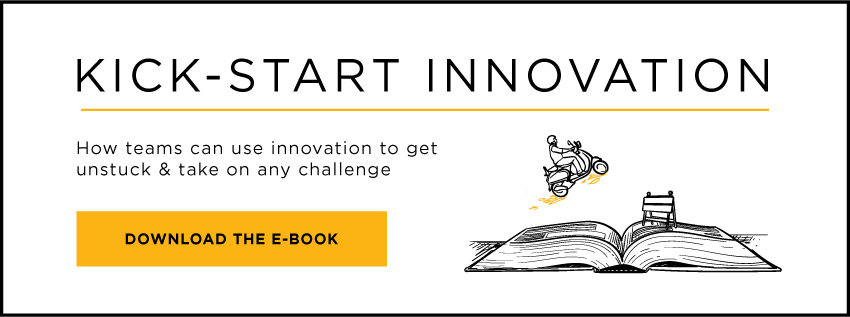 As an organization development practitioner, I’m always looking for new approaches to inspire the leaders I work with, and to help them find ways to engage their teams to be more innovative. When I discovered design thinking four years ago, I was excited. Design thinking is an optimistic, human-centered approach to problem solving, that when combined with other leadership and team development processes, can transform a team’s culture and performance.
As an organization development practitioner, I’m always looking for new approaches to inspire the leaders I work with, and to help them find ways to engage their teams to be more innovative. When I discovered design thinking four years ago, I was excited. Design thinking is an optimistic, human-centered approach to problem solving, that when combined with other leadership and team development processes, can transform a team’s culture and performance.
When leaders embrace design thinking as part of their leadership philosophy, it helps to develop a team environment where creative ideas flourish, solutions gain traction, and people feel empowered to challenge assumptions, learn and push the boundaries of what’s possible. These are the conditions where innovation happens.
Another foundation of design thinking is diversity and collaboration, where teams comprised of diverse people feel safe to fully show up to offer their unique experience and strengths. When people gain cohesion as a team and leverage all their collective strengths, they will produce new ideas — and the leader sets the tone for trust and inclusion that makes it possible for these amazing things to happen.
While this all may sound straightforward in theory, I have learned that, in practice, it is often a challenge for leaders to strike the right balance between the classic ways they have been rewarded for getting results, with the proven mindsets and processes for performing in an increasingly complex and ambiguous world. Creating an environment that encourages creativity and experimentation, sometimes means less focus on following established structures and plans. This may feel messy and uncomfortable, but that is exactly what innovation feels like in the early stages of learning the process.
If you are a leader who wants to cultivate innovative teams and leverage the power of design thinking, you will need to be willing to strike a balance on these five things:
-
Analytical thinking with empathy. Clear-headed, rational, analytic thinking will always be important ingredients to solving complicated problems. If you want to fully benefit from the impact design thinking can have on creating game changing customer solutions, you will want to start a design thinking process with a mindset of empathy and developing a deep emotional understanding of the customer. It is from a place of empathy where the best insights surface, and clarity on which solutions will be the most use and value to the customer.
-
There is one right answer to there are many possible solutions. Some problems do have one answer. An established proven process that malfunctions can often be fixed with a single solution. However, design thinking is for human-centered, complex challenges that works best when you start from a mindset of “not knowing” and recognizing there are many paths that can lead to successful outcomes. When leaders balance the need for certainty and predictability with openness for discovery, experimentation, and creativity, the best solutions will naturally surface.
-
Expertise and judgement with learning and vulnerability. The curse of innovation is knowledge and the expertise and judgement that comes with it — the antidote to this curse is learning through vulnerability. When leaders and teams acknowledge that they aren’t the experts, it pushes them to look outside themselves and collaborate to find answers. Vulnerability is the strength that guides them through their collective learning towards new ideas and creates a meaningful platform to engage with customers and end users. This is vital energy to the design thinking process.
-
Driving for results with the process of discovery. The things leaders are often rewarded for — metrics, outputs, and fast results —need to be set aside in the early stages of the innovation process. Instead, leaders must focus their attention on celebrating the processes of generating ideas, empathizing with customers, and responding to feedback. Acknowledging the importance of discovery that goes into design thinking creates an innovative culture and drives measurable results down the line.
-
Getting it right the first time with embracing iteration. It’s easy to fall in love with an early idea and treat it as a fully formed solution. Unfortunately, that position may prevent the team from making the idea better. Innovation is an iterative journey that requires us to fall in love with the problem and embrace the trial and error of experimentation and the learning that comes with it.
We all develop our own unique patterns of leading and sometimes they become so ingrained we lose sight of them and how they impact our work and interactions with the teams we lead. When investing in the process of design thinking, some of these five balancing acts may feel unfamiliar and uncomfortable for you depending on which direction you most often lean towards in your leadership style. I believe when leaders have the courage to push themselves beyond their comfort zone and established patterns and into a place of learning and championing innovation, they will find that they have cultivated an environment where their teams are more engaged, creative, and inspired to create real and lasting value for their customers.
Learn how to enable innovation skill-building at scale here or download our free ebook Kickstart Innovation: A Guide for Organizations.
Tammie Plouffe is a professional Organizational Development consultant focused on assisting business leaders in developing innovative and lasting solutions to their leadership and organizational challenges.
Tammie is managing partner of Innovative Pathways and has assisted many large global and mid-sized organizations with leadership and team development programs, culture transformation, innovation initiatives, strategy retreats and meeting facilitation.
